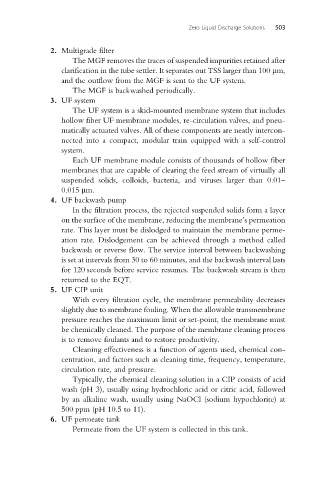Page 533 - Industrial Wastewater Treatment, Recycling and Reuse
P. 533
Zero Liquid Discharge Solutions 503
2. Multigrade filter
The MGF removes the traces of suspended impurities retained after
clarification in the tube settler. It separates out TSS larger than 100 mm,
and the outflow from the MGF is sent to the UF system.
The MGF is backwashed periodically.
3. UF system
The UF system is a skid-mounted membrane system that includes
hollow fiber UF membrane modules, re-circulation valves, and pneu-
matically actuated valves. All of these components are neatly intercon-
nected into a compact, modular train equipped with a self-control
system.
Each UF membrane module consists of thousands of hollow fiber
membranes that are capable of clearing the feed stream of virtually all
suspended solids, colloids, bacteria, and viruses larger than 0.01–
0.015 mm.
4. UF backwash pump
In the filtration process, the rejected suspended solids form a layer
on the surface of the membrane, reducing the membrane’s permeation
rate. This layer must be dislodged to maintain the membrane perme-
ation rate. Dislodgement can be achieved through a method called
backwash or reverse flow. The service interval between backwashing
is set at intervals from 30 to 60 minutes, and the backwash interval lasts
for 120 seconds before service resumes. The backwash stream is then
returned to the EQT.
5. UF CIP unit
With every filtration cycle, the membrane permeability decreases
slightly due to membrane fouling. When the allowable transmembrane
pressure reaches the maximum limit or set-point, the membrane must
be chemically cleaned. The purpose of the membrane cleaning process
is to remove foulants and to restore productivity.
Cleaning effectiveness is a function of agents used, chemical con-
centration, and factors such as cleaning time, frequency, temperature,
circulation rate, and pressure.
Typically, the chemical cleaning solution in a CIP consists of acid
wash (pH 3), usually using hydrochloric acid or citric acid, followed
by an alkaline wash, usually using NaOCl (sodium hypochlorite) at
500 ppm (pH 10.5 to 11).
6. UF permeate tank
Permeate from the UF system is collected in this tank.

